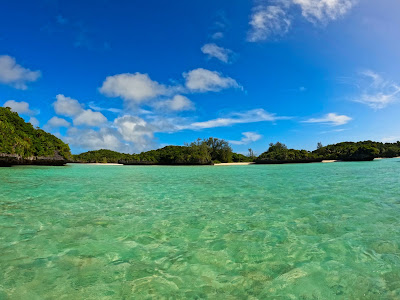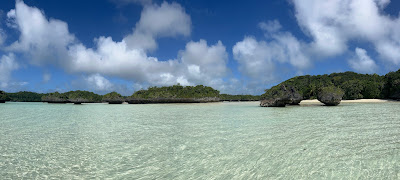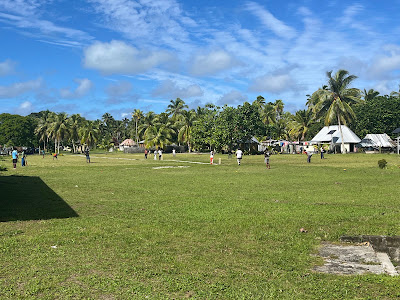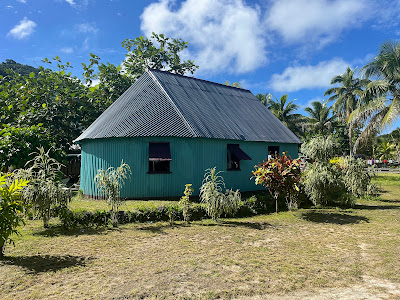 |
| Chief Simon of Fulaga- the original "Simon Says" |
Fiji has been our favorite cruising ground EVER. And I mean since that day in 2011 when we moved onto L'ORIENT full time. But going to Fiji and missing the Lau Group would have been like seeing Paris without the Eiffel Tower.
As L'ORIENTals are aware, we were hiding from cyclones in the Yasawas in April and early May, close to the expensive hurricane pit that we hoped we were done with. And Neptune smiled on us because we avoided any serious weather badness during this time. We returned to Port Denarau Marina - our launching pad for some massive provisioning. Two months of food, fuel, and spare parts. We accomplished this with three massive shopping trips that included some extras. The Lau Group is very traditional and very remote. Gifts for the local chiefs (yes I'm serious), children, and others were a necessity to gain permission to anchor among their islands. So, throw in a frisbee with that canned tuna. And how about a side order of coloring books with that frozen chicken.
 |
| Our Kava root offerings; ground up this becomes the "chill" drink of choice |
And we amassed no fewer than 20 Kava root bundles, those bark-like things that are used by Fijians to make a narcotic-like drink (we've never had it). And off we went, heading Southeast with the maximum amount of food and fuel that we could carry.
Sailing directly into the prevailing wind is difficult, and while we had good South wind at times, the 350 miles we covered resulted in us having to motor for about half of it. Kind of a problem when you carry limited fuel. But we hit our first Lau Group island.........the Yagasa Cluster. We met a grand total of zero people on this island because it has no people. Welcome to Lau!
 |
| No lights, footprints, or any evidence of man- totally uninhabited |
 |
| View off the bow- totally stunning |
Our first big problem emerged on the boat. The piece of rigging that controls our genoa sail (80 pct of the power of the boat during sailing) broke in big wind. Uh oh. So, because we have a spare, I thought I'd pop the new one on. But the $1500 spare I had recently purchased had the holes drilled in the wrong places in the big aluminum casting. If you're in a machine shop or somewhere in civilization, you can break out your drill press and make quick work of this problem. But with a power drill and a dremel on a rolly boat? This took 4 days and we are still cleaning up those sharp little aluminum shards.
 |
If you look closely through the keyhole - there's the boat
|
 |
| Looking into our swimming hole, known by us as "Secret Beach" |
 |
| Nothing but emptiness |
 |
| Nice view of L'ORIENT anchored in 50 ft |
It had now been ten days since we had seen a boat, person, or a light anywhere. We arrived in Ogea (the next island) knowing there was a village of 90 people, accessible only at high tide; the inlet leading to the settlement dries up completely at low tide. And as a bonus, they were listed in our guide as having diesel fuel for sale.
 |
| The lucky winner of our first frisbee give-away |
Ogea's village was full of friendly people. The chief happened to be on his deathbed (he's 83), so we were not allowed to meet him. The next in command of these islands is referred to as the "head man", kind of a vice-chief. We bonded with him, gave him a kava root, some fishing lures, etc. Some local kids got crayons, coloring books, and a frisbee. Ogea gets a supply ship once per month, which by chance arrived at the same time we did. Due to the shallow water, it stays anchored way out and the villagers use their seven small skiffs to offload their supplies. We helped unload things and carried them into the very small market. Wanting to replace our diesel, we gingerly inquired about buying some. We were led to a rusty, unmarked drum and told this was diesel.........for $10 US per gallon. We bought some, but we are still not sure we will put it in our tank as we're not positive what it is we bought.
 |
| What more can you say about the colors we see daily- spectacular |
 |
| Deceptively calm inlet- outside it's very rolly for L'ORIENT |
Ogea's bays and inlets are too shallow for our boat to enter, so we had to treat it as a roadstead and anchor outside. Big problem.........very, very rolly at times. Bigger problem... it is so beautiful that we don't want to leave and dealt with the roll and lack of sleep. Kirstin was in paddle boarder paradise and the beaches were perfection.
 |
| These weird volcanic "mushrooms" are everywhere |
 |
| More swimming holes than anyone could enjoy in a lifetime |
 |
| Tidal range can be as much as 8 ft here |
After two reasonable nights where we were convinced that it wasn't too bad, we were then subjected to three nights of intense roll. Crash, bang, no sleep. Time to leave.
 |
| Happy but needing sleep... |
Only five miles from Ogea lies our primary destination, Fulaga. Billed by sailors we respect as the most beautiful place in the South Pacific, we decided to go there right away. Fulaga is completely ringed by a protective reef, has clear turquoise water everywhere and these remarkable volcanic rock "mushrooms" growing out of the sea with trees and vegetation all over them. Simply stunning. But, of course, there is a catch. The only way to enter Fulaga is through a VERY NARROW pass with occasionally high current. Oh and after you get through the pass you have to steer extremely close to a "mushroom" to avoid some very nasty coral. We used charts (all flawed) and satellite images (a life-saver) to make a plan.

Above is our satellite image of the pass. About 150 ft wide at the mouth (where you don't need the space), but 50-60 ft wide near the end (where you do). And you interpret the depth of the water by the shade of blue........not enormously sophisticated. Other sailors had posted unhelpful remarks like "I had to get uncomfortably close to the rock". What the hell does that mean ?
Below, the Navionics chart of Fulaga's pass and the dotted line representing our actual track. You can see the chart is totally useless and following the chart's path would have resulted in hitting the reef (hard). You can see we circled 6 times in front of the mouth because a) we couldn't see it and b) it looked scary. Finally we just went for it.
Ironically, just after we got here a sailing yacht hit a reef in the Lau Group 50 miles east of here. While the sailors were rescued by a nearby cruising boat, their boat was destroyed and lost. We try to always remind ourselves there is no rewind button out here. One mistake is all it takes.
 |
| Nothing as heartstopping as watching your depth go from 1000 ft to 5 ft in a few boat lengths |
Scared doesn't describe our emotions, but we stuck to our course and made it through without hitting anything. Whew.
 |
| Was it worth it? Yeah |
Being the best place in the world, of course we chose an anchoring spot with no fewer than 3 private beaches for ourselves, aquamarine water, and privacy from the 5 other boats in this huge lagoon.
 |
| Real head-scratcher.......how does this even exist ? |
Our trip in to meet the chief was successful. Chief Simon made us wait outside his "palace" for about five minutes.......kind of a power thing........and then invited us in. He sat on the floor and had a booming baritone voice - his voice was very James Earl Jones. Very Chiefly, this Simon. We won him over with the fact that we brought him not the required one Kava root, but two. He was delighted.
He gave us some interesting facts about island history, culture, etc. Interestingly, depending on who you talk to (Simon, the Headman, or the guide-book), Fulaga either has 200, 300, or 400 residents. Hmm. I'm sure they will clear this up at the next census.
My main questions went kind of unanswered.......Why is it important to give Kava to the Chief ? (Because it is). Why do the locals (and us) refrain from wearing hats and sunglasses in the village? (Because everyone knows it's rude). Oh, of course.
 |
| The main village is 15 minutes down this mosquito infested path |
 |
| View of the outer reef- Fulaga is completely ringed |
 |
| Another pristine beach |
Simon invited us to everything and assigned us a host family, who fell all over themselves being friendly and serving us afternoon tea.
 |
| Our host family with a snack. Really good bread with peanut butter and herbal tea; but a fly swatter is an important utensil |
 |
| Host family's house |
Our host family lives across from the Primary school so we had front row seats to watch the kids and their antics. Fulaga does not have a Secondary school so the kids must move to the big town of Suva (population roughly 100,000) and attend the boarding school there. Quite a transition for a kid from this quiet, tiny island.
 |
| Mini- the super talented wood carver; we plan to patronize his "shop" this week |
 |
| Una (the teacher) in the foreground with kids at recess |
 |
| Kids being kids |
We happened to walk into town on the day of the big cross island cricket challenge. Kind of the Friday Night Lights of Fulaga. The competition seemed fairly fierce and we were surprised to see so many young men as many normally work either on mainland Fiji or overseas and send money back home.
 |
| A serious cricket game- beautiful setting but still the most boring sport on earth |
Fortunately the island has not been affected by a cyclone since 2018 according to Chief Simon. Despite it causing some damage to the forest apparently it did not impact any of the buildings. The exterior of most homes are built with corrugated steel and many are in an oval shape to better deflect the wind. Once inside the building is reinforced with massive beams as you can see inside the chief's home - the beams are adorned with masi made from the bark of a tree and then decorated.
 |
This house isn't going anywhere
|
 |
| Rounded houses deflect high winds during cyclones |
 |
| They do what they can for housing here- not enough building materials to go around |
So as I write this, we are still pinching ourselves that we are here. The moon is full (making for great happy hours sitting on the bow), and we will now try to make this moment last for as long as possible.
 |
| This is actually moonrise the other night- |
We may not move the boat for five, six or seven weeks. How long can we make our diesel and food last? We will see. Enjoy the pictures.
 |
| The view from our boat in Fulaga - not leaving anytime soon |
 |
| A totally crazy seascape. |


































